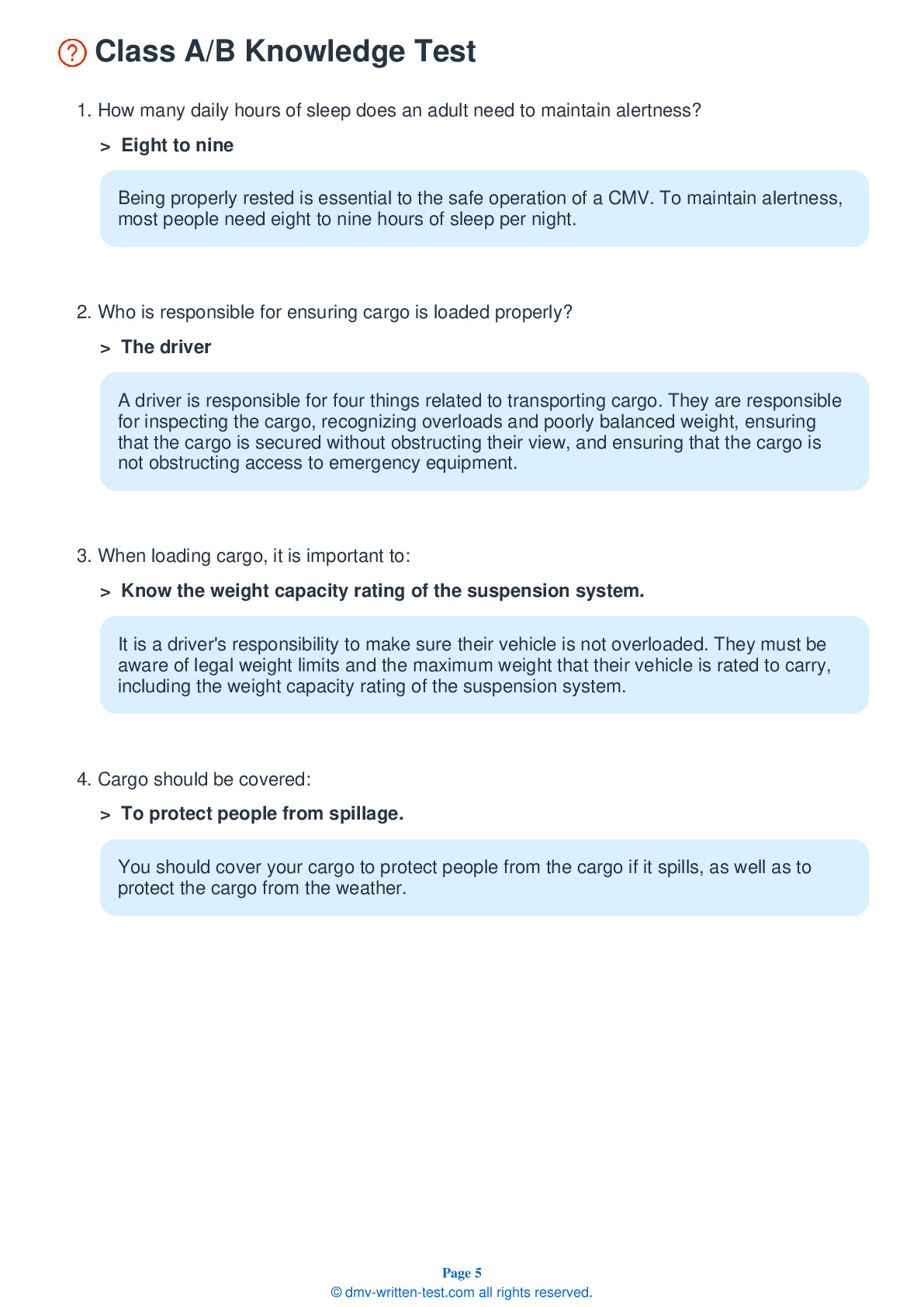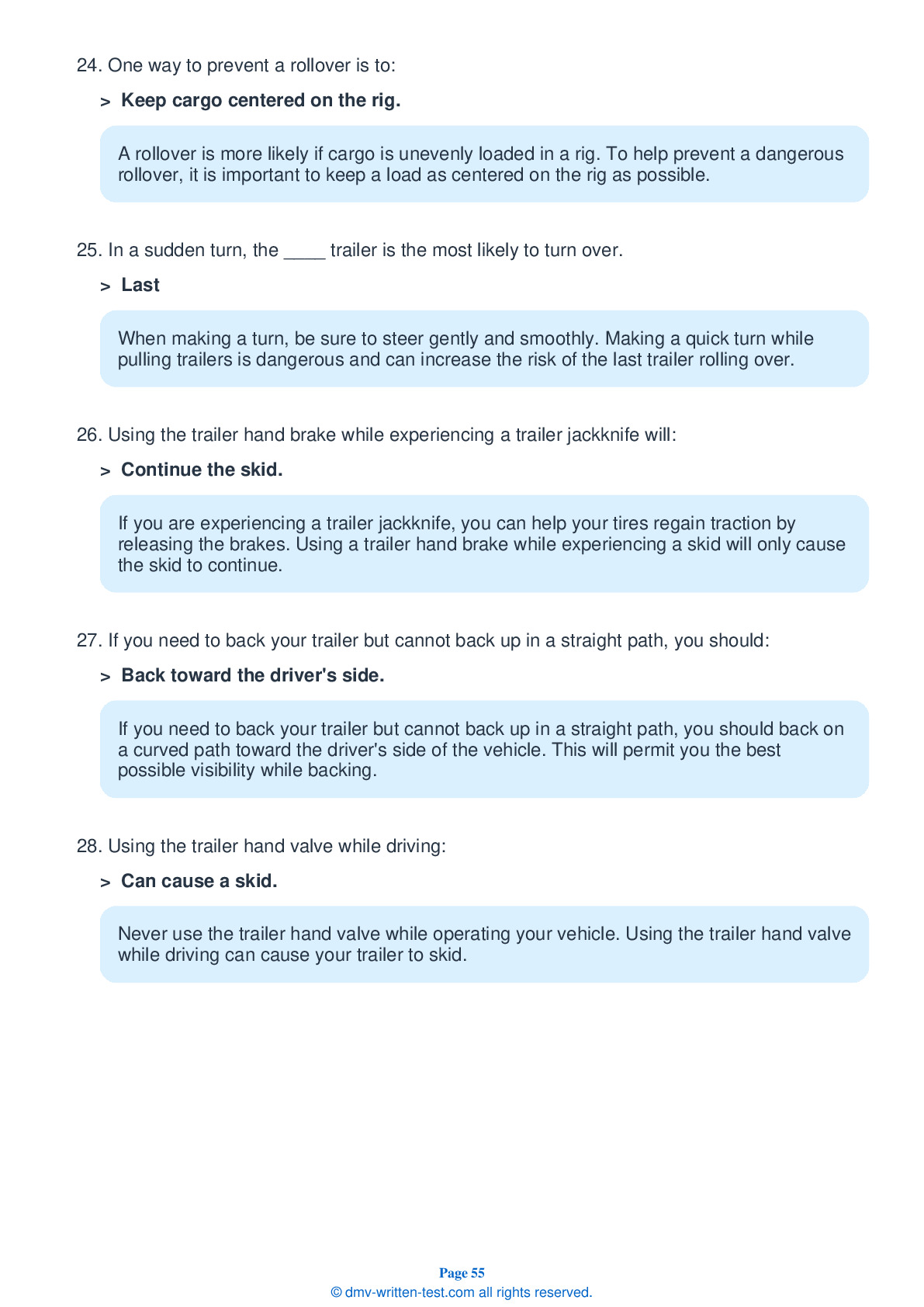Knowledge Test Class B
This license is required for driving a single vehicle with a GVWR of more than 26,001 pounds, and a trailer not to exceed 10,000 pounds gross vehicle weight rating, or a vehicle designed to transport 24 or more people (including the driver). To receive this license, applicants must pass a 50-question test. To pass, applicants must answer 40 questions correctly. Each question has three possible answer choices. Test questions come from the Hawaii Commercial Driver License Manual. Questions come from chapters covering: Introduction, Driving Safely, Transporting Cargo Safely, Air Brakes (if applicable), Pre-Trip Vehicle Inspection Test, Basic Vehicle Control Skills Test and On-Road Driving.. Endorsements that may be used with a Class B CDL are: Hazardous materials, Tank, Passenger, HazMat and Tank, Air Brakes and School bus.
43. Pre-trip inspections should be done:
A pre-trip inspection should be completed in the same way before every drive. Consistency will help you learn all of the proper steps and decrease the likelihood that you will forget to check something.
44. Once the air tanks are at an air pressure level of 125 psi, the air compressor governor will:
An air compressor governor will stop the compressor from pumping air once the air tanks are at an air pressure level around 125 psi. This air pressure level is referred to as the "cut-out" level.
45. If there is a fire in your vehicle and you are not sure how to extinguish it, you should:
If you are not sure which method to use when putting out a fire, do not attempt to extinguish the fire on your own. Instead, wait for firefighters to arrive and let them handle it. This is especially true if you are experiencing a hazardous materials fire.
46. An Individual Vehicle Distance Record (IVDR) does not need to include which of the following?
An Individual Vehicle Distance Record (IVDR) must include information about the distance traveled by a vehicle and the amount of fuel purchased. The required distance information includes the dates of a trip and the total distance traveled by the vehicle.
47. Rust around wheel nuts may mean:
Rust around wheel nuts may mean that they are loose. Check the tightness of the nuts if you see any rust in the area.
48. Looking far ahead of your vehicle while driving is:
Good drivers look down the road at least 12 to 15 seconds ahead of their vehicles. This makes it possible to identify hazards early, when drivers are more likely to have time to respond appropriately.
49. To avoid a hazard:
In some emergencies, the best strategy for avoiding a hazard may be to drive onto the shoulder. Most shoulders are strong enough to support the weight of a large vehicle.
50. When making tight maneuvers, it is important for a driver to:
While regular mirror checks should always be part of your driving routine, you should make a particular point of checking the mirrors when changing lanes, turning, merging, or making tight maneuvers.
Frequently Asked Questions
1. Obtain a Hawaii Commercial Learner's Permit (CLP) by passing the written knowledge test for Class B vehicles.
2. Practice driving with your CLP for at least 14 days.
3. Schedule and pass a skills test with a qualified examiner. The skills test consists of three parts: pre-trip inspection, basic vehicle control, and on-road driving.
4. Complete any additional requirements such as endorsements if needed.
5. Submit the necessary paperwork and fees to the Hawaii Department of Transportation.
It's important to note that before obtaining a Class B CDL license in Hawaii, you must have a valid Hawaii driver's license and be at least 18 years old (21 years old for interstate travel).
- Straight trucks
- Large buses, such as school buses or passenger buses
- Segmental buses
- Box trucks
- Dump trucks
- Cement mixers
- Garbage trucks
It's important to note that if you need to operate a vehicle that requires additional endorsements, such as a hazardous materials endorsement or passenger endorsement, you must obtain those endorsements in addition to your Class B CDL license.
1. Be at least 18 years old (21 years old for interstate travel).
2. Have a valid Hawaii driver's license.
3. Obtain a Hawaii Commercial Learner's Permit (CLP) by passing the written knowledge test for Class B vehicles.
4. Hold your CLP for at least 14 days before taking the skills test.
5. Pass a skills test with a qualified examiner, which includes a pre-trip vehicle inspection, basic vehicle control, and on-road driving test.
6. Submit to a medical examination and obtain a valid medical certificate.
7. Provide proof of your identity and residency in Hawaii.
8. Pay the necessary fees.
It's important to note that if you have a history of certain medical conditions or substance abuse, you may be disqualified from obtaining or renewing your CDL license. Additionally, if you have been convicted of certain offenses, such as driving under the influence (DUI), you may be ineligible to obtain or renew your CDL license.
1. Passenger Endorsement (P) - allows you to drive a commercial vehicle designed to transport 16 or more passengers, including the driver.
2. School Bus Endorsement (S) - allows you to drive a school bus.
3. Tank Vehicle Endorsement (N) - allows you to drive a commercial vehicle that transports liquids or gases in bulk.
4. Hazardous Materials Endorsement (H) - allows you to transport hazardous materials that require placarding.
5. Combination Tank and Hazardous Materials Endorsement (X) - allows you to transport both hazardous materials and liquids or gases in bulk.
To obtain an endorsement, you must pass additional written knowledge tests and meet specific requirements, such as obtaining a background check and passing a Transportation Security Administration (TSA) security threat assessment for the Hazardous Materials endorsement.
1. Pre-trip Inspection: You will be asked to inspect your vehicle and explain to the examiner what you are checking and why. The inspection covers items such as brakes, steering, lights, tires, and more.
2. Basic Vehicle Control: You will be asked to demonstrate your ability to control the vehicle in various situations, including straight-line backing, alley dock backing, offset backing, and parallel parking.
3. On-road Driving: You will be asked to drive your vehicle on public roads while the examiner evaluates your ability to follow traffic laws and safely operate the vehicle in various situations.
During the skills test, you will be graded on your ability to perform each task safely and correctly. To pass the test, you must not accumulate more than 30 points of errors during the pre-trip inspection or basic vehicle control portions of the test and not commit any critical errors during the on-road driving portion. Critical errors include things like traffic violations or accidents.
1. Passenger Restrictions: If you have a Class B CDL with a passenger endorsement, you may not transport more than 16 passengers (including the driver) at a time.
2. Weight Restrictions: Depending on the endorsement you hold, there may be weight restrictions on the type of vehicle you can operate. For example, if you have a Class B CDL with a tank vehicle endorsement, you may not operate a tank vehicle that weighs more than 26,000 pounds.
3. No Trailer Restrictions: A Class B CDL does not allow you to tow trailers that weigh more than 10,000 pounds. If you need to tow heavier trailers, you will need to obtain a Class A CDL.
4. Hazardous Materials Restrictions: If you have a hazardous materials endorsement, there may be additional restrictions on the types of materials you can transport and where you can travel.
5. Medical Certificate Requirement: To maintain your Class B CDL, you must pass a medical examination and obtain a valid medical certificate every two years.
It's important to understand and follow all restrictions and limitations associated with your Class B CDL in order to avoid penalties or potentially losing your license.
However, it's important to note that the skills test (the driving portion of the CDL exam) is only administered in English. So even if you take the written test in another language, you will still need to be proficient in English to pass the skills test and obtain your CDL.
If you do choose to take the written test in a language other than English, be sure to let the licensing examiner know before you start the exam. They will provide you with an appropriate translation or interpreter, if needed.
Some examples of accommodations that may be available include extra time to complete the test, a separate testing room, or a sign language interpreter. To request accommodations, you will need to contact the Hawaii Department of Transportation's CDL office and provide documentation of your disability.
It's important to make your request for accommodations as early as possible, as it may take some time to arrange for the necessary accommodations. The CDL office will work with you to determine what accommodations are appropriate and available.
If you fail the written test, you will need to wait at least one business day before you can retake it. If you fail the test three times, you will need to wait at least 30 days before you can take it again.
It's important to note that there may be a fee associated with retaking the test. You should check with the Hawaii Department of Transportation's CDL office to find out what the fee is and what forms of payment are accepted.
When you retake the test, you will be given a different version of the test than the one you took previously. This is to ensure that you have a fair opportunity to pass the test. If you have any questions about retaking the Class B CDL written test in Hawaii, contact the CDL office for more information.




